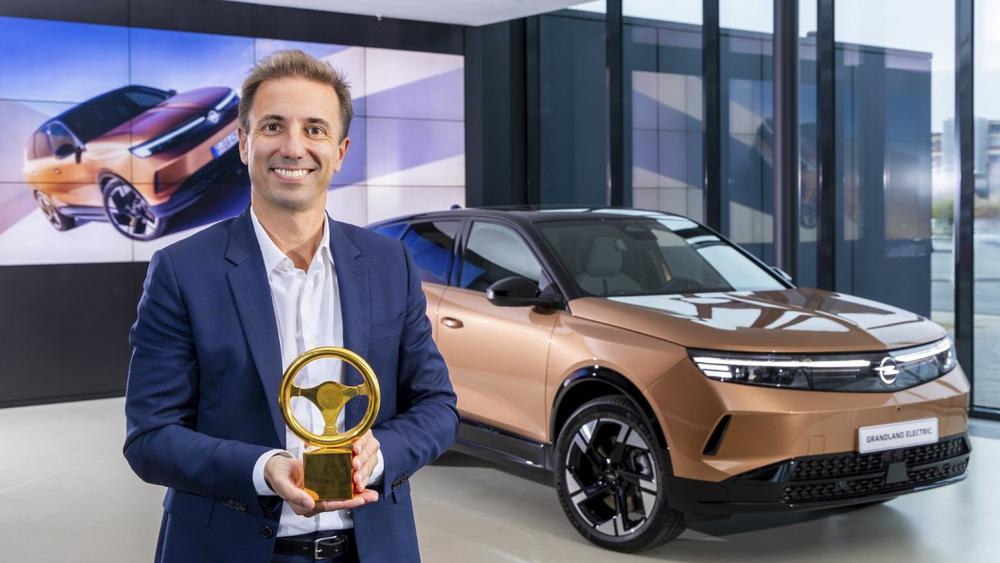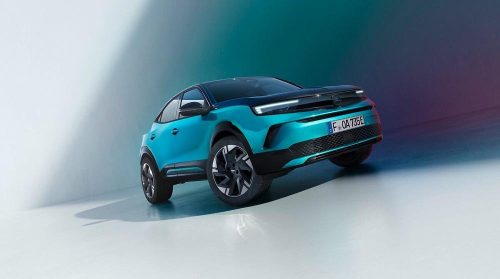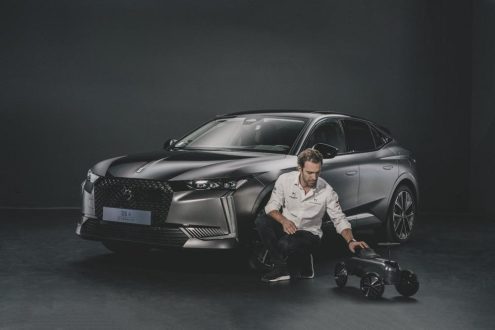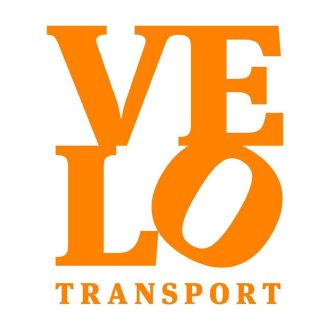
Grand Title: New Opel Grandland Wins ‘2024 Golden Steering Wheel’
- Best car under €50,000’1: New top-of-the-line SUV strikes gold
- Serial winners: 21 ‘automotive Oscars’ for brand with the Blitz to date
The new Opel Grandland, which will arrive at dealerships soon, has already been able to celebrate its first major success. The top-of-the-line SUV has won the ‘2024 Golden Steering Wheel’ in Germany. Stylish, dynamic, spacious and with an electrified drivetrain portfolio – all strong arguments that convinced the experts to name the newcomer ‘made in Germany’ ‘Best car under €50,000’. The award presented by AUTO BILD and BILD am SONNTAG is recognised as one of the most renowned of its kind in the automotive industry. This year’s award for the all-new Grandland takes Opel’s overall ‘Golden Steering Wheel’ tally to 21.
“The new Opel Grandland is already bringing the automotive future to the road. It is the first Opel on a BEV-native platform. This enables exemplary locally emissions-free ranges combined with excellent comfort. This blend combined with the bold and pure Opel design is exceptional. We are delighted that AUTO BILD and BILD am SONNTAG have rewarded this innovative spirit with the Golden Steering Wheel,” said Opel CEO Florian Huettl at the award ceremony in Berlin’s Axel Springer Haus.
“The Opel Grandland convinces with its distinctive design and modern cockpit. And it shows how important it is today to give customers freedom when choosing their drive. Whether hybrid, plug-in hybrid or fully electric – everyone will find the right variant,” said Robin Hornig, editor-in-chief of AUTO BILD.
Opel clearly presented what it means by “German Energy” and how the brand envisions the automotive future with the Opel Experimental concept car. The all-new Opel Grandland is already making many of the Experimental’s visionary innovations a reality. The top-of-the-line SUV is the first Opel on the BEV-native STLA Medium platform and offers numerous groundbreaking technologies, clever equipment and sustainable solutions. It always shines with the new 3D Vizor – depending on the trim even for the first time with an illuminated Opel Blitz. When viewed from the rear, the Grandland also has the continuously illuminated Opel wordmark.
In the cockpit, Grandland drivers look at two widescreen displays. Together with the optional Intelli-HUD (head-up display), they ensure that the driver can always keep his eyes on the road. In addition, Pure Mode reduces the content displayed to a necessary minimum at night or at higher speeds. The ergonomic seats with individually adjustable side cushions, certified by Aktion Gesunder Rücken e.V. (AGR), also ensure pure and, above all, relaxed driving pleasure; the patented Intelli-Seat ergonomics feature is standard on both front seats. Safety and comfort are increased by features such as the adaptive, glare-free Intelli-Lux HD light with more than 50,000 elements and the practical Pixel Box. It has an illuminated, translucent glass surface under which the smartphone can be inductively charged. And with a volume of up to 1,645 litres, the new Grandland has plenty of loading space.
Opel and the ‘Golden Steering Wheel’: The 21 winners from Rüsselsheim
The all new Opel Grandland is the latest in a proud line of ‘Golden Steering Wheel’ winners from Opel. The award, which has been presented since 1976 by the Axel Springer publishing house BILD am SONNTAG (as of 2009 in cooperation with AUTO BILD) was won for the 21st time by the German carmaker. It all started in 1978, two years after the award was founded, with the Opel Senator A.
1978 – Opel Senator A: The first ‘Golden Steering Wheel’
In 1978, the brand with the Blitz won its first ‘Golden Steering Wheel’ with the Opel Senator. Presented at the IAA in September 1977, the Senator was the successor of the legendary Kapitän, Admiral and Diplomat models and was Opel’s top-of-the-line model until making its final bow in 1993. The 1978 Senator was available with three different engines – a 2.8-litre with 103 kW (140 hp), a 3.0-litre unit with 110 kW (150 hp) and the top-of-the-range 3.0-litre engine with 132 kW (180 hp).
1979 – Opel Kadett D: The award-winning space wonder
One year later, Opel was back on the top of the rostrum. The 1979 Kadett D was the first ever Opel compact class car with front-wheel drive and delivered the company’s second ‘Golden Steering Wheel’. Thanks to the transverse engines and the lack of a propellor shaft it offered the passengers ample space despite compact dimensions and being 126 mm shorter than its predecessor. In addition to the spacious estate with a load volume of up to 1,425 litres, Opel offered two different fastback versions. In January 1983, the sporty Kadett GTE followed, with a top speed of 187 km/h and equipped with a 1.8-litre four-cylinder engine that developed 85 kW (115 hp).
1981 – Opel Ascona C: Good things come in threes
In 1981, it was the Opel Ascona C’s turn to bring home the goods for the Rüsselsheim-based carmaker. It was the first Opel midsize car with front-wheel drive and was available as a notchback and an estate. The powertrain range for the Ascona C consisted of petrol engines ranging from 1.3 to 1.6 litres and a 1.6-litre diesel.
1982 – Opel Corsa A: Small car, huge impact
Only 12 months later, in 1982, a brand-new Opel model took the ‘Golden Steering Wheel’ awards by storm and became a highly acclaimed top seller – the Corsa A. Opel’s first-ever small car featured close-coupled proportions within a short length of just 3.62 metres. It had bold, flared wheel-arches like a rally car and an exceptionally low drag coefficient of 0.36. The highlight was the 72 kW (98 hp) Corsa GSi. The two-door hatch and notchback line-up was expanded in 1985 with the addition of the popular five-door model.
1984 – Opel Kadett E: Another compact class winner
Five years after winning the ‘Golden Steering Wheel’ for the first time, the Kadett took pole position again with its new generation launched in 1984. The second front-wheel drive Kadett, built from 1984 to 1991, was an absolute winner and also took the 1985 ‘Car of the Year’ award. Furthermore, the Kadett is rated as an aerodynamics champion. The sporty GSi, with a Cd of 0.30, stunned the experts and even the normal hatchback sedan achieved a sensational value of 0.32.
1987 – Opel Senator B: Smooth-running winner
The Opel Senator B also managed to repeat the success of its predecessor. Based on the rear-wheel drive Opel Omega, the new flagship mainly came with six-cylinder engines, with the smooth 3.0-litre in-line engine with 115 kW (156 hp) leading the way. You could place a coin on its edge in the engine compartment and the coin wouldn’t fall off when the engine was running. Later, a four-valve version of the six-cylinder engine with a Dual-Ram variable intake system and hearty 150 kW (204 hp) was introduced.
1990 – Opel Calibra: The champion wins
A true champion won the ‘Golden Steering Wheel’ in 1990: A breath-taking coupé with a record-breaking drag coefficient of 0.26! The Calibra was available with powerful engines ranging from 85 kW (115 hp) to 150 kW (204 hp). The Opel Calibra Turbo with all-wheel drive and acceleration from zero to 100 km/h in a mere 6.8 seconds was the icing on the cake. A V6 engine with 125 kW (170 hp) rounded off the offer. In motorsports, a Calibra V6 won the touring car crown by taking the ITC in 1996.
1994 – Opel Omega B: The big car takes gold
The second edition of the Omega left a special impression on the jury. The dynamic design, the extensive amount of space and the new V6 engines with alloy cylinder heads and up to 155 kW (210 hp) impressed the experts. The new airbag systems ensured a high level of safety for all occupants. The estate version boasted sheer endless loading capacity, making it the ideal car for families and artisans alike, whereas the limousine version was rated as a representative business sedan.
1995 – Opel Vectra B: Mirror, mirror, on the door
The Opel Vectra’s most eye-catching features were the aerodynamically shaped door mirrors that formed a harmonic unity with the front of the car – a feature the ‘Golden Steering Wheel’ jury simply could not resist. The Vectra also won because of its new and efficient petrol engines ranging from 1.6 to 2.6 litres featuring outputs between 55 kW (75 hp) and 125 kW (170 hp). Elsewhere, the direct injection diesel engines with displacements ranging from 1.7 to 2.2 litres delivering exemplary consumption celebrated their debut.
1999 – Opel Zafira A: The quick-change artist with seven seats
Who invented it? Opel! Yes, the compact van that can be turned from a complete seven-seater into a transporter with impressive maximum load volume (1,700 litres max.) in a flash without removing a single seat is a Rüsselsheim brainchild. The formula is called Flex7 and it helped the Zafira win the ‘Golden Steering Wheel’ in 1999. Thanks to the ingenious concept, the seats disappear into the vehicle floor when necessary. The flexible space wonder also impresses with compact dimensions and outstanding driving dynamics.
2002 – Opel Vectra C: The master electrician
The third-generation Vectra successfully defended the title won by its predecessor by winning gold yet again. The new midsize car entered the electronic age, connected its systems via a CAN (Controller Area Network) bus instead of via a wiring harness, and came with electrohydraulic power steering. Outputs of the petrol and diesel engines ranged from 74 kW (100 hp) to 206 kW (280 hp) with displacements from 1.6 to 3.2 litres. In 2004, Opel also fitted the Vectra with the IDS Plus active suspension with Continuous Damping Control (CDC), which ensured that the dampers adapt to the prevailing driving situation.
2005 – Opel Zafira B: Completing the golden dozen
The second-generation Zafira continued to set the standards with a further development of the Flex7 seating system and won the ‘Golden Steering Wheel’ again. Furthermore, it was also classed as the fastest van on the planet when the OPC version with 177 kW (240 hp) completed a lap on the Nürburgring Nordschleife in 8:54:38 minutes. The 240 powerful horses under the bonnet and an outstanding performance handling system helped achieve this record-breaking time.
2009 – Opel Astra J: The compact designer piece
In 2009, the Astra J, a true designer piece, followed in the footsteps of the Kadett D space wonder and the Kadett E aerodynamics champion, securing Opel’s third “Golden Steering Wheel” compact class title. The Astra followed Opel’s new design philosophy ‘Sculptural artistry meets German precision’. In additional, the Astra J came with modern assistance systems such as the Opel Eye and the AFL+ headlamp system that can see around corners. The FlexRide adaptive technology helped it adapt to the prevailing driving situation and front-seat occupants were able to enjoy the ride in AGR-certified (Campaign for Healthier Backs) seats.
2010 – Opel Meriva B: So clever, so compact
The Zafira’s little brother struck gold in 2012 with the Meriva B underlining Opel’s van expertise. The jury was convinced by the versatile FlexSpace rear-seating system and the innovative rear-hinged rear door system. The FlexDoors allow easy access to children’s seats in the rear and ensured comfortable entry and egress for tall passengers. The engine portfolio offered ample power while curbing consumption thanks to downsizing and turbo-charging. Outputs ranged from 55 kW (75 hp) to 103 kW (140 hp).
2012 – Opel Zafira Tourer: The lounge on wheels
The Zafira was accompanied by a premium partner in the Zafira Tourer and immediately won another ‘Golden Steering Wheel’. In addition to the flexible interior, the newcomer impressed with lounge comfort, panorama glass sunroof and innovations such as radar-based speed control and Forward Collision Alert.
2015 – Opel Astra K: The quantum leap
The Astra K was based on a completely new lightweight vehicle architecture, powered exclusively by ultra-modern engines and enabled outstanding connectivity, e.g. via smartphone integration. The Astra also continued Opel’s tradition of introducing features previously only known from higher segments into the compact segment. All this resulted in the 2015 ‘Golden Steering Wheel’.
2017 – Opel Ampera-e: The electric range champion
The Opel Ampera-e leaves its competition standing with its sports car-like acceleration and the by far longest electric range in its segment. With a single charge of the 60-kWh lithium-ion battery a distance of up to 520 kilometres is measured in accordance with the New European Driving Cycle (NEDC). And the Opel Ampera-e also impresses when tested approximated to the speed profile defined in the WLTP2 (Worldwide Harmonized Light-Duty Vehicles Test Procedure) driving cycle (shortened test procedure): Based on this development test, the engineers estimate a combined WLTP2 range of 380 kilometres. The Ampera-e accelerates from 0 to 50 km/h in just 3.2 seconds. Furthermore, the 4.16 metre-long Ampera-e also offers plenty of space for up to five passengers plus boot space of 381 litres (1,274 litres when the seats are folded down).
2020 – Opel Corsa-e: Electrified bestseller
With the sixth generation of the Corsa, the best-selling small car has become electric. Thanks to the 50-kWh battery, the Corsa-e can travel up to 353 kilometres on a single charge (according to the WLTP cycle2) and is therefore suitable for everyday use. There is space for up to five occupants and the entry-level version already features numerous high-tech assistance systems.
2021 – Opel Mokka-e: Bold, pure, unconventional and locally emissions-free
The Opel Corsa-e is followed by the Opel Mokka-e as ‘Golden Steering Wheel’ winner3. With the Opel Vizor brand face on the outside and the fully digital Pure Panel on the inside, the bold and pure SUV impresses immediately. In addition, as a battery-electric Mokka-e, it has a locally emissions-free range of up to 338 kilometres (according to WLTP2) without a charging stop.
2022 – Opel Astra L: Design statement with technologies of the future
The Opel Astra has achieved a double-triple in the ‘Golden Steering Wheel 2022’4. The current Astra generation is the third in succession to receive the prestigious award. At the same time, Opel has won for the third year in a row. The design of the Astra and Astra Sports Tourer is bold and pure, from the Opel Vizor on the outside to the all-digital Pure Panel in the cockpit. Then there are the top technologies that make driving safer and more enjoyable. In addition, the powertrains of the latest-generation Astra are fit for the future. Opel’s bestselling compact is available in numerous electrified versions – as a plug-in hybrid or hybrid with 48V technology as well as fully battery-electric.
2024 – New Opel Grandland: Electrified top SUV with innovative technologies
The Astra’s successor as the latest ‘Golden Steering Wheel’ winner is the new Opel Grandland – a top-of-the-line SUV that already brings many visionary ideas to life and is the first Opel based on the BEV-native STLA Medium platform. The newcomer, which can already be ordered, is electrified in every variant and, thanks to the new architecture, will offer a battery capacity of 97 kWh and a locally emissions-free range of up to around 700 kilometres (WLTP5). In addition, it is the first Opel with 3D Vizor including an illuminated Opel flash at the front and continuously illuminated OPEL lettering at the rear. Safety and comfort features such as the adaptive Intelli-Lux HD light with more than 50,000 LED elements, the practical, translucent pixel box in the centre console and standard Intelli-Seats with a central recess take it to the next level.
[1] AUTO BILD edition 46/2024 and BILD am SONNTAG edition 45/2024, category ‘Best car under €50,000’.
[2] Range determined according to WLTP test procedure methodology (R (EC) No. 715/2007, R (EU) No. 2017/1151). The actual range can vary under everyday conditions and depends on various factors, in particular on personal driving style, route characteristics, outside temperature, use of heating and air conditioning and thermal preconditioning.
[3] AUTO BILD edition 45/2021 and BILD am SONNTAG edition 46/2021, category for ‘Best car under €25,000’.
[4] AUTO BILD edition 45/2022 and BILD am SONNTAG edition 46/2022, category for ‘Best car under €50,000’.
[5] Preliminary range values determined according to WLTP test procedure methodology (R (EC) No. 715/2007, R (EU) No. 2017/1151). The actual range can vary under everyday conditions and depends on various factors, in particular on personal driving style, route characteristics, outside temperature, use of heating and air conditioning and thermal preconditioning. Preliminary values, vehicle not available yet.
Opel is one of the largest European car manufacturers and a leader in the reduction of CO2 emissions thanks to its extensive electrification offensive. The company was founded by Adam Opel in Rüsselsheim, Germany, in 1862 and started building automobiles in 1899. Opel is part of Stellantis NV, a global leader created for the new era of sustainable mobility. Together with its British sister brand Vauxhall, the company is represented in more than 60 countries around the globe, continuing to enter new international markets. Opel is currently consistently implementing its electrification strategy to secure sustainable success and ensure that the future mobility demands of customers are met. By 2024, a battery-electric variant of each Opel model will be available.
Visit https://int-media.opel.com
Opel Automobile GmbH
Bahnhofsplatz
65423 Rüsselsheim
Telefon: +49 (6142) 7-70
Telefax: +49 (6142) 77-8409
http://de-media.opel.com/de
Communications, Manager International Product
Telefon: +49 (6142) 69-22084
E-Mail: colin.yong@stellantis.com
Telefon: +49 (6142) 6927811
E-Mail: carina.elsinger@opel-vauxhall.com
Telefon: +49 (6142) 6927466
E-Mail: leif.rohwedder@opel-vauxhall.com
![]()




